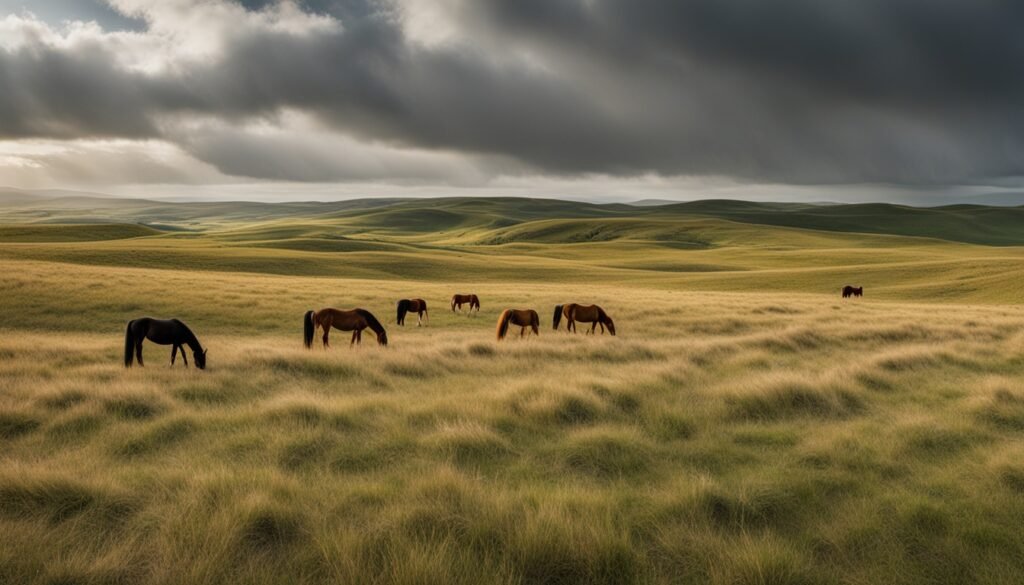In the vast expanse of grasslands, where the horizon stretches endlessly, the interplay between the acoustic environment and the communication strategies of equines takes on a unique and captivating dimension.
As horses roam these open spaces, their vocalizations, from the gentle nicker to the powerful whinny, serve as a vital means of conveying information, maintaining social bonds, and navigating the intricacies of their herd dynamics.
Yet, the very nature of the grassland landscape, with its undulating terrain and varying vegetation, can significantly impact the way sound travels and is perceived by these magnificent creatures.
This article delves into the fascinating realm of grassland acoustics and its profound influence on equine communication. By exploring the nuances of sound propagation in open environments, the unique auditory capabilities of horses, and the intricate interplay between the acoustic landscape and animal behavior, we uncover insights that not only deepen our understanding of equine ecology but also inform practical applications in equine management and welfare.
Key Takeaways
- Grasslands provide a unique acoustic environment that can significantly impact the way sound travels and is perceived by equines.
- Equine vocalizations are a vital means of communication, conveying information, maintaining social bonds, and navigating herd dynamics.
- Understanding the factors that influence sound propagation in open spaces, such as topography and vegetation, is crucial for interpreting equine behavior and communication.
- Auditory perception in horses is highly specialized, allowing them to detect and interpret a wide range of sounds within their environment.
- Integrating knowledge of grassland acoustics and equine communication can enhance welfare and management practices in equine facilities and settings.
Introduction to Grassland Acoustics
Grasslands are expansive, open environments that harbor a unique acoustic environment. Understanding the nuances of Grassland Acoustics is crucial for studying the role of sound in these diverse ecosystems.
At the heart of this field lies the concept of Soundscape Ecology, which explores the intricate relationship between living organisms and the acoustic properties of their habitats.
Defining the Acoustic Environment
The acoustic environment of grasslands is characterized by its vast, open spaces and the absence of prominent physical barriers. This allows sound waves to propagate freely, creating a soundscape that is often dominated by the vocalizations of various animal species, including Bioacoustics.
The complex interplay between topography, vegetation, and atmospheric conditions shapes the unique acoustic properties of these environments.
Importance of Sound in Grasslands
In grassland ecosystems, sound plays a vital role in the communication, orientation, and survival of numerous species. Grassland Acoustics influence the way animals perceive and interact with their surroundings, affecting behaviors such as mating, territorial defense, and predator-prey interactions.
Understanding the significance of sound in these open environments is crucial for researchers and land managers to optimize wildlife conservation and management strategies.
Equine Communication and Vocalizations
In the world of animal behavior, equine communication plays a crucial role in understanding the social dynamics and cognitive abilities of horses. Equine vocalizations, in particular, offer a unique window into the complex language used by these majestic creatures.
Horses, like many other animals, use a variety of vocal cues to convey their emotions, intentions, and social status. These vocalizations can range from the familiar whinny to more subtle grunts, snorts, and neighs, each serving a specific purpose in the horse’s repertoire of animal behavior.
Equine vocalizations can serve a multitude of functions, including:
- Social bonding and herd cohesion
- Alarm signaling and predator avoidance
- Dominance and submission displays
- Maternal-offspring communication
- Coordination of group movement and activities
By understanding the nuances of equine vocalizations, researchers and equine professionals can gain valuable insights into the communication patterns and social dynamics of these highly social animals.
The study of equine vocal communication not only enhances our appreciation for the cognitive and emotional complexity of horses but also has practical applications in areas such as equine management, training, and welfare.
Sound Propagation in Open Spaces
When it comes to understanding the acoustic environment of grasslands, sound propagation plays a crucial role. Sound waves, the carriers of auditory information, travel and interact with the landscape in fascinating ways.
The factors that influence sound transmission in open spaces like grasslands are multifaceted, and uncovering these dynamics can provide valuable insights into equine communication.
Factors Affecting Sound Transmission
Several key factors contribute to the way sound propagates through open environments. One of the primary influences is topography. The undulating terrain, hills, and valleys can either facilitate or hinder the transmission of sound waves, affecting their volume, clarity, and reach.
Additionally, the vegetation present in grasslands can interact with sound, reflecting, absorbing, or refracting the waves, leading to various acoustic effects.
Another important consideration is the ambient noise level within the grassland ecosystem. The presence of wind, weather conditions, and other natural sounds can create a dynamic acoustic environment that shapes how equine vocalizations are perceived and interpreted by both horses and their human observers.
Influences of Topography and Vegetation
The interplay between topography and vegetation is particularly fascinating in grassland settings. Gentle slopes and undulating landscapes can act as natural amplifiers, channeling sound waves and enhancing their reach.
Conversely, dense vegetation like tall grasses or shrubs can dampen and scatter sound, creating acoustic shadows and altering the perceived volume and clarity of equine communications.
Understanding these nuances of sound propagation in open spaces is crucial for researchers and equine enthusiasts alike. By delving deeper into the physical dynamics at play, we can better appreciate the complexity of the acoustic environment and its impact on the ways horses convey information to one another and interact with their surroundings.
Auditory Perception in Horses
Understanding the auditory perception of horses is crucial for comprehending their communication and behavior within the grassland ecosystem. Horses possess a remarkable ability to interpret the acoustic cues present in their environment, which plays a vital role in their survival and social interactions.
Equine Hearing Capabilities
Horses are equipped with a sophisticated auditory system that allows them to perceive a wide range of sound frequencies. Studies in animal behavior and bioacoustics have revealed that equines can hear frequencies ranging from 55 Hz to 33.5 kHz, with the most sensitive range between 1 kHz and 16 kHz.
This auditory perception enables them to detect subtle changes in their surroundings and respond accordingly.
| Hearing Range | Sensitivity |
|---|---|
| 55 Hz – 33.5 kHz | 1 kHz – 16 kHz |
The equine hearing system is particularly attuned to low-frequency sounds, which are prevalent in the open grassland environment. This sensitivity allows horses to detect distant calls, rustling vegetation, and the approaching footsteps of predators or other horses, enabling them to respond accordingly and maintain their safety and social cohesion.
By understanding the unique auditory perception of horses, researchers and equine professionals can gain valuable insights into their animal behavior and communication, ultimately enhancing their welfare and management in the grassland habitat.

Grassland Acoustics and Equine Communication
Vocal Communication in Horses
In the expansive grasslands, the unique soundscape plays a vital role in shaping how horses communicate with one another.
The open spaces and sparse vegetation of these environments allow Grassland Acoustics to have a significant influence on the way Equine Communication and Vocal Communication unfold.
Horses, being highly social animals, rely extensively on vocalizations to convey a range of information, from expressing emotions to coordinating herd movements.
The acoustic properties of grasslands, such as reduced sound absorption and efficient sound propagation, can amplify and carry these equine vocalizations over substantial distances.
This interplay between Grassland Acoustics and Equine Communication has profound implications for the Behavioral Ecology of horses.
The ability to transmit and receive vocal signals effectively allows horses to maintain cohesion within their herds, coordinate their activities, and respond to potential threats or opportunities from afar.
| Vocal Behavior | Grassland Acoustics | Implications |
|---|---|---|
| Whinnies and Neighs | Efficient sound propagation | Allows horses to communicate over longer distances, facilitating herd coordination and social interactions |
| Contact Calls | Reduced sound absorption | Enables horses to maintain auditory contact with herd members, even when visually obscured by terrain or vegetation |
| Alarm Calls | Rapid signal transmission | Helps horses quickly alert their herd to potential threats, enhancing their collective vigilance and responsiveness |
By understanding the intricate relationship between Grassland Acoustics and Equine Communication, researchers and equine professionals can gain valuable insights into the Behavioral Ecology of horses and develop strategies to support their welfare and management in these open environments.
Behavioral Ecology of Sound
The acoustic environment plays a crucial role in shaping the Behavioral Ecology of animals, including horses. Sound serves as a vital medium for Animal Behavior, facilitating communication, social dynamics, and overall well-being.
In the context of grasslands, the open spaces and unique topographical features can significantly impact sound propagation, influencing how horses perceive and respond to their auditory surroundings.
One key aspect of Behavioral Ecology is the way animals use sound to convey information and coordinate their activities. Horses, for example, employ a diverse range of vocalizations to communicate with herd members, signal their intentions, and respond to their environment.
The Bioacoustics of these vocal cues can provide valuable insights into the social and ecological factors shaping equine communication.
Furthermore, the Soundscape Ecology of grasslands can have a profound impact on the way horses perceive and interact with their surroundings.
The acoustic characteristics of the habitat, such as the presence of natural or anthropogenic noise sources, can influence the horses’ ability to detect and respond to important auditory signals, ultimately affecting their overall well-being and behavior.
By understanding the intricate relationship between Behavioral Ecology, Animal Behavior, Bioacoustics, and Soundscape Ecology, researchers and equine professionals can develop more effective strategies for managing and enhancing the welfare of horses in grassland environments.
This holistic approach to understanding the role of sound in animal behavior can lead to important advancements in the field of equine management and conservation.
Soundscape Ecology in Grasslands
Soundscape Ecology, a field that explores the acoustic environments surrounding us, holds valuable insights into the intricate world of grasslands. These open spaces are teeming with a symphony of sounds, each contributing to the rich tapestry of the ecosystem.
By monitoring the acoustic environment in grasslands, researchers can gain a deeper understanding of the complex interactions between the land, the wildlife, and the auditory landscape.
Monitoring Acoustic Environments
Studying Soundscape Ecology in grasslands involves the use of specialized tools and techniques. Researchers employ a variety of sound recording devices, strategically placed within the landscape, to capture the auditory fingerprint of the environment.
This data is then analyzed, revealing patterns, rhythms, and changes in the Grassland Ecology over time.
The information gathered through Monitoring the acoustic environment can shed light on the behavior and communication of the resident wildlife, including the Equine Communication of horses. By understanding the soundscapes of grasslands, researchers can gain valuable insights into the overall health and dynamics of these vital ecosystems.
| Monitoring Technique | Application | Advantages |
|---|---|---|
| Audio Recorders | Capture the full range of sounds in the grassland | Provide comprehensive data for analysis |
| Acoustic Indices | Measure the diversity and complexity of the soundscape | Offer insights into the overall health of the ecosystem |
| Bioacoustic Surveys | Identify and track individual species through their vocalizations | Valuable for understanding animal behavior and population dynamics |

By employing these and other innovative techniques, researchers in the field of Soundscape Ecology are unlocking the secrets of the Acoustic Environment in grasslands, ultimately contributing to our understanding and preservation of these vital natural landscapes.
Applications in Equine Management
The insights gained from understanding grassland acoustics and equine communication can be leveraged to enhance the welfare and management of horses, particularly in areas where they are exposed to open spaces.
By considering the acoustic environment and its impact on equine behavior, equine professionals can make informed decisions to improve the well-being of their animals.
Enhancing Welfare through Acoustics
Acoustic management in equine facilities can contribute to the overall welfare of horses. For example, designing stabling and training areas with sound-absorbing materials can minimize echoes and reverberation, creating a more calming environment.
Additionally, understanding the horses’ auditory perception can help identify and mitigate potential sources of stress or discomfort, such as sudden or loud noises.
Incorporating the principles of soundscape ecology can also aid in monitoring and managing the acoustic environment in equine facilities. By analyzing the soundscape, equine professionals can identify any imbalances or disruptions that may impact the horses’ well-being and take appropriate actions to address them.
| Acoustic Considerations for Equine Welfare | Benefits |
|---|---|
| Sound-absorbing materials in stabling and training areas | Reduced echoes and reverberation, creating a more calming environment |
| Identification and mitigation of potential noise sources | Reduced stress and discomfort for horses |
| Monitoring and management of the acoustic environment | Improved understanding of the soundscape and its impact on equine behavior and welfare |
By incorporating acoustic management strategies into their equine operations, professionals can enhance the well-being of their horses and create a more harmonious environment that supports their natural behaviors and communication.
Conclusion
As we’ve explored throughout this article, the intricate relationship between grassland acoustics and equine communication holds profound implications for the field of animal behavior, bioacoustics, and the well-being of our equine companions.
The open spaces of grasslands create a unique acoustic environment that profoundly shapes how horses engage in vocal communication, perceive their surroundings, and navigate their social and physical world.
By understanding the principles of sound propagation in these expansive landscapes, we gain valuable insights into the auditory capabilities of horses and the ways in which they use vocalizations to convey important information.
This knowledge not only enhances our appreciation for the remarkable adaptations of these majestic creatures but also provides a foundation for improving equine management practices, enhancing animal welfare, and fostering deeper connections between humans and horses.
As we continue to explore the fascinating realm of grassland acoustics and equine communication, we open the door to new possibilities in the fields of bioacoustics, conservation biology, and the overall understanding of animal behavior.
By embracing this interdisciplinary approach, we can unlock the secrets of the equine soundscape, empowering us to create environments that support the natural communication and well-being of these beloved companions.
FAQ
What is the relationship between grassland acoustics and equine communication?
The unique acoustic environment of open spaces, such as grasslands, can influence the way sound propagates and affects the ability of horses to communicate effectively through vocalizations. Understanding this relationship is important for understanding equine behavior and communication.
How does the acoustic environment of grasslands differ from other environments?
Grasslands have a unique acoustic environment characterized by factors like open spaces, topography, and vegetation, which can significantly impact sound transmission and the way animals, including horses, perceive and use sound.
What are the different types of equine vocalizations and what purpose do they serve?
Horses use a variety of vocalizations, such as whinnies, neighs, and snorts, to communicate information about their social status, emotional state, and other aspects of their behavior. These vocalizations serve important functions in the horse’s social and behavioral repertoire.
How do factors like topography and vegetation affect sound propagation in grasslands?
The topography and vegetation of grasslands can significantly influence the way sound waves travel and interact with the environment. This can impact the range and clarity of equine vocalizations, potentially affecting their ability to communicate effectively.
What are the auditory capabilities of horses, and how do they perceive sound in their environment?
Horses have a well-developed sense of hearing, with the ability to perceive a wide range of frequencies and sound intensities. Understanding their auditory perception is crucial for comprehending how they interpret and respond to the acoustic cues in their environment, including those in grassland settings.
How does the grassland soundscape influence equine communication and behavior?
The unique acoustic environment of grasslands can impact the way horses use vocalizations to convey information and interact with one another. This can have wider implications for their social dynamics, foraging behavior, and overall well-being within the grassland ecosystem.
How can the insights from grassland acoustics and equine communication be applied to enhance the management and welfare of horses?
By understanding the relationship between the acoustic environment and equine communication, researchers and equine professionals can develop strategies to create optimal conditions for horses, particularly in areas where they are exposed to open spaces like grasslands. This knowledge can be used to improve horse management and welfare.

